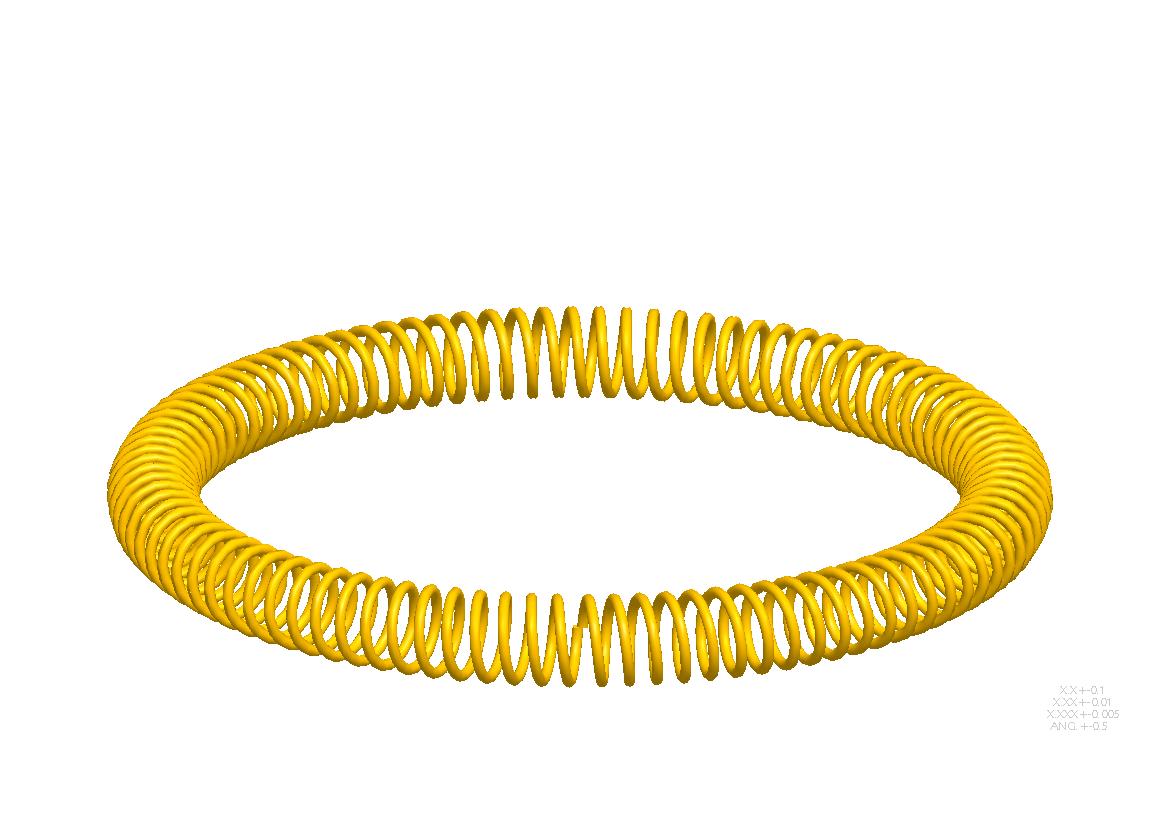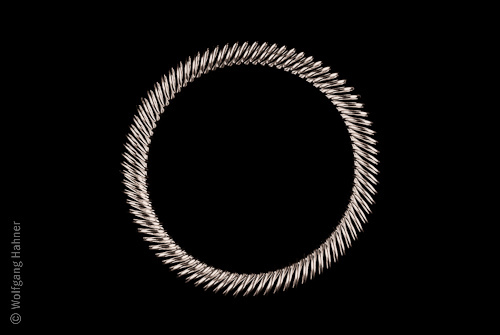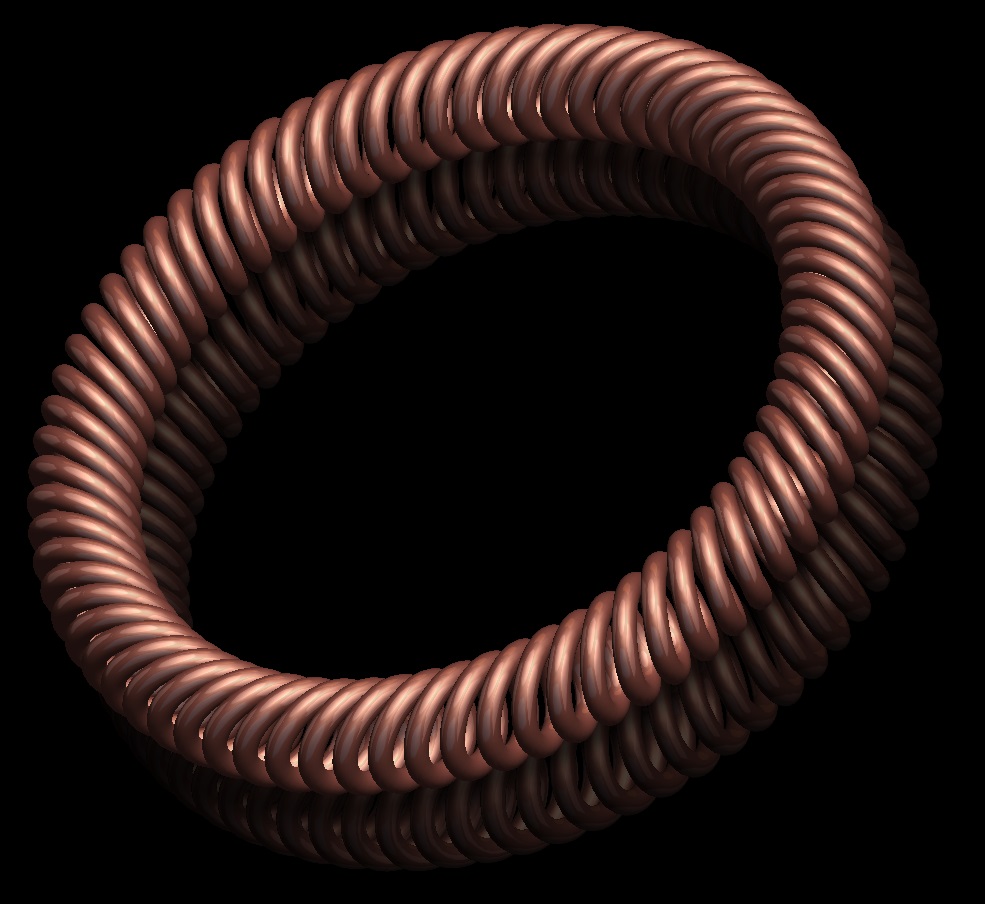Community Tip - Stay updated on what is happening on the PTC Community by subscribing to PTC Community Announcements. X
- Community
- Creo (Previous to May 2018)
- Creo Modeling Questions
- Re: Modelling a 'Canted' spring in Wildfire 4.0 ?
- Subscribe to RSS Feed
- Mark Topic as New
- Mark Topic as Read
- Float this Topic for Current User
- Bookmark
- Subscribe
- Mute
- Printer Friendly Page
Modelling a 'Canted' spring in Wildfire 4.0 ?
- Mark as New
- Bookmark
- Subscribe
- Mute
- Subscribe to RSS Feed
- Permalink
- Notify Moderator
Modelling a 'Canted' spring in Wildfire 4.0 ?
Hi all,
I'm attempting to model a canted coil spring in WF4.0 but have only managed to model what is in effect a 'garter spring'. The difference being the coils of the canted spring are not perpendicular to the trajectory but are 'canted' over at an angle.
These are sometimes referred to as 'Balseal' springs.
Can anyone offer any help on this please?
I've attached an image of the spring I've modelled as well as a photo of a true canted coil spring.
Any help appreciated.
Thanks.


Solved! Go to Solution.
Accepted Solutions
- Mark as New
- Bookmark
- Subscribe
- Mute
- Subscribe to RSS Feed
- Permalink
- Notify Moderator
- Mark as New
- Bookmark
- Subscribe
- Mute
- Subscribe to RSS Feed
- Permalink
- Notify Moderator
Warp would help but you don't have that in WF 4, right?
What if you created 1 coil and patterned them from an "offset" center?
- Mark as New
- Bookmark
- Subscribe
- Mute
- Subscribe to RSS Feed
- Permalink
- Notify Moderator
Correct, no warp here !
Are you saying just model 1 'ring' and pattern it so I'd have a pattern of canted rings rather than a continuous spring?
Thanks
- Mark as New
- Bookmark
- Subscribe
- Mute
- Subscribe to RSS Feed
- Permalink
- Notify Moderator
Correct. I recommend using the geometry pattern. In the longrun, it has the same efficiency on the GPU and probably faster on the regens. Long sweeps of circles are really high overhead on the system.
- Mark as New
- Bookmark
- Subscribe
- Mute
- Subscribe to RSS Feed
- Permalink
- Notify Moderator
Try page 19 of this thesis...
I was able to get some of the equation to work using an equation by curve.
http://tam.northwestern.edu/joswald/data/thesis-jjo.pdf
I am going to go out on a limb and say you can absolutely do this once you find the right equation. I tried both a cylindrical coordinate system and a cartesian one (the kind used in the thesis). I could get ONE canted coil but I was having trouble making a string of them. I'd bet that you can either create the coil using an equation and then just sweep to make the physical coil geometry... OR that you could take a simple loop and use the trajpar variable with some type of equation to generate the geometry.
Seriously... this is a job for Vladimir Palffy. He'd have this thing modeled in under an hour... and then he'd render it so it looked like a real spring. Maybe he'll chime in if he's not busy.
Let us know if you make any progress.
Thanks!
-Brian
- Mark as New
- Bookmark
- Subscribe
- Mute
- Subscribe to RSS Feed
- Permalink
- Notify Moderator
Actually... Frank might have some tricks for this, too. I forgot he's also a whiz with springs. I always thought I was really good with them until Frank showed me some of the stuff I had missed.
We have some really excellent members who would probably love a challenge such as this. I'm one of them... I'm just preoccupied at the moment!
Good luck!
- Mark as New
- Bookmark
- Subscribe
- Mute
- Subscribe to RSS Feed
- Permalink
- Notify Moderator
Nope... Spinal bend! (Frank would be proud!)
Wrap a sketch around a cylinder using a curve. Something like this: ~
Pattern the sketch and use it for a sweep of a line (to get a surface for the spinal bend)
Spinal Bend the surface
Use the surface edge for a sweep
Remember the limitations of Spinal Bend doesn't allow geometry beyond the two datum planes. You need to be very specific about the end conditions.
I'll post up the process I used in a bit.
Brian; that paper is excellent. It is mostly concerned with load bearing coils. As you are probably well aware, these are often used on shipping pallets to minimize transport shock and vibration. Typically, they are very heavy steel cable coils fixed to mounting plates tangent to the coils.
- Mark as New
- Bookmark
- Subscribe
- Mute
- Subscribe to RSS Feed
- Permalink
- Notify Moderator
I would like to know if there is an easier way, but all this is supported in WF 4.
As noted above, and I forgot to make it clear in the video (leave the web crowd guessing ![]() ) if the position of the wrap-sketch in relation to the start plane of the spinal bend.
) if the position of the wrap-sketch in relation to the start plane of the spinal bend.
So here's the sketch:
The spring mean diameter is 6 and that is the relation 6*pi (circumference=pi*D) and my pitch is 4. I divided the sketch along the spinal bend start plane so I would have a good joining at the end.
I also did not put all the possible relations in there but you could make this very dynamic.
I have a pattern of 41 wraps to make for 40 coils in the end. The mean diameter is 6. The Spinal Bend sketch can be managed by relations so you could have it change ID/OD/or Mean diameters as a flexible model.
Using Spinal bend also makes the overall height moot, since the spinal bend determines "stretching". The only thing that governs min is the relation between wire diameter and spring mean diameter.
The video!
- Mark as New
- Bookmark
- Subscribe
- Mute
- Subscribe to RSS Feed
- Permalink
- Notify Moderator
Forgot the glamor shot...
Creo 2.0 file attached
- Mark as New
- Bookmark
- Subscribe
- Mute
- Subscribe to RSS Feed
- Permalink
- Notify Moderator
Nice!
- Mark as New
- Bookmark
- Subscribe
- Mute
- Subscribe to RSS Feed
- Permalink
- Notify Moderator
Hi Antonius,
I'm struggling to define my sketched spline as per yours.... How are the 'black' lines contrained ?
Thanks again.
Just answered my own question - switched to Polygon mode....
Message was edited by: Paul Moss
- Mark as New
- Bookmark
- Subscribe
- Mute
- Subscribe to RSS Feed
- Permalink
- Notify Moderator
If you double click the spline you get the option to control the spline by the Control Polygon Mode. Once you accept, you can manage the curvature of the spline.
- Mark as New
- Bookmark
- Subscribe
- Mute
- Subscribe to RSS Feed
- Permalink
- Notify Moderator
Thanks - got that working, although I'm now struggling with my swept surface along the patterned curve - can't seem to select any more that the original curve. Almost as if the the patterned curve is not continuous! Pretty sure it is tho as I measured the pitch of the curve on the cylinder just to double-check and its the same as the pattern dimension.,,
- Mark as New
- Bookmark
- Subscribe
- Mute
- Subscribe to RSS Feed
- Permalink
- Notify Moderator
True, I had to select each segment individually with the CTRL key held fast to sweep the surface.
Once it is a surface, however, the Tangent collector works on the surface's edge (after the spinal bend).
- Mark as New
- Bookmark
- Subscribe
- Mute
- Subscribe to RSS Feed
- Permalink
- Notify Moderator
Yeah I've tried that but get the message ' specified trajectory is not valid' !
I did notice on your Creo version however that you used 'copy geom' then patterned that.
We don't have adv. assy here so don't have copy geom unfortunately....
- Mark as New
- Bookmark
- Subscribe
- Mute
- Subscribe to RSS Feed
- Permalink
- Notify Moderator
It is not copied per-se. It is a geometry pattern rather than a normal pattern. I think it is the same as saying "identical" in WF4.
The ends must be tangent when you copy them. Any error and it will choke. Try it with a pair of opposing arcs rather than the spline and see if you have better luck controlling it. Again, making the "~" shape.
- Mark as New
- Bookmark
- Subscribe
- Mute
- Subscribe to RSS Feed
- Permalink
- Notify Moderator
Hey... no Spinal Bend... that's cheating. You can make almost anything with one of those. Try it with a straight equation!
- Mark as New
- Bookmark
- Subscribe
- Mute
- Subscribe to RSS Feed
- Permalink
- Notify Moderator
Creo is all about getting the work done...
sometime in this century ![]()
...within a few gazillion mouse-clicks!
I'll let the math-geeks do the equations.
I'm still open to seeing other ideas ![]()
- Mark as New
- Bookmark
- Subscribe
- Mute
- Subscribe to RSS Feed
- Permalink
- Notify Moderator
Hmmmm, now THAT is an interesting spring. Might have to play with that one......
The questions I have is if you section the spring thru the toroidial axis, is the section of the spring circular, or elliptical? In other words, is it simply a garter spring, but with the outer toroidial coils displaced torsionally relative to the inner coils, so that the section would be elliptical? Or, is it displaced torsionally AND have a circular cross section? Hmmm......
- Mark as New
- Bookmark
- Subscribe
- Mute
- Subscribe to RSS Feed
- Permalink
- Notify Moderator
The section remains round... -IF- you sweep the wire -after- the spinal bend.
- Mark as New
- Bookmark
- Subscribe
- Mute
- Subscribe to RSS Feed
- Permalink
- Notify Moderator
Nice!![]()
- Mark as New
- Bookmark
- Subscribe
- Mute
- Subscribe to RSS Feed
- Permalink
- Notify Moderator
Sorry for the confusion, not the wire section itself, but the toroidial section. Sorry! I've never actually seen one in the flesh....or at least looked at it closely.
- Mark as New
- Bookmark
- Subscribe
- Mute
- Subscribe to RSS Feed
- Permalink
- Notify Moderator
I see... yep, it starts out a squished spring... like someone stepped on it with forward motion. Still round, but skewed.
- Mark as New
- Bookmark
- Subscribe
- Mute
- Subscribe to RSS Feed
- Permalink
- Notify Moderator
I specifically stayed away from the warp in the initial look at this because the OP is on WF4.
But I thought Warp would do it in one feature, but it still had trouble. I did "flatten" and "smear" the coil with Warp, but still went with the fine control of the Spinal Bend to get the ends to meet perfectly.
The good thing is, I learned how to apply specific values on the Warp feature sliders (arrows). It is likely the -worst- UI I have -ever- used.
The bad thing was the fact that although the bend feature should have worked perfectly, it didn't. There was no way I could close the end.
PTC!!! You still have a lot of work to do on making the Warp feature, the entire collection!!! ...usable to replace some of the legacy features. Do -NOT- take out the legacy features for Creo 3.0!
- Mark as New
- Bookmark
- Subscribe
- Mute
- Subscribe to RSS Feed
- Permalink
- Notify Moderator
Yeah, I think the Warp features are more for models going to an animation program perhaps? Because there really is no way to finely control the output. I mean, they seem pretty robust in that you can REALLY "tweak" (Oops! Sorry, used old terminology.... ![]() ) the geometry, but you can't use it for anything. What I'd REALLY like to see is making Spinal Bends work at the assembly level, for, say, wiring harnesses and/or flex circuits. Also, from what I've tried, the spine of a spinal Bend must be planar. Think what you could do if it WASN'T.
) the geometry, but you can't use it for anything. What I'd REALLY like to see is making Spinal Bends work at the assembly level, for, say, wiring harnesses and/or flex circuits. Also, from what I've tried, the spine of a spinal Bend must be planar. Think what you could do if it WASN'T. ![]()
Yeah, I used a Spinal Bend on mine too. Funny, in all the years, I hadn't used that command much, now I've used it a lot in just the last year or so. I'm getting to like it more and more. A "Golden Oldie" for sure.
- Mark as New
- Bookmark
- Subscribe
- Mute
- Subscribe to RSS Feed
- Permalink
- Notify Moderator
I figured that was the case. If you think about how they'd manufacture it. I don't know if it's possible to start with, essentially, a metal o-ring, and wind it that way. What they probably do, is use a typical spring machine (we had a bunch where I used to work, pretty cool stuff!) and simply make a coil spring. Then squish it like you mentioned, then essentially do a spinal bend on it and weld the ends together.
As always when trying to reproduce a part, you must look closely at the method of manufacture to find out what the geometry REALLY is. I'd love to have a large one to look at. ![]()
Nice work! Have I gotten you hooked on spinal bends or what? LOLZ.... ![]()
- Mark as New
- Bookmark
- Subscribe
- Mute
- Subscribe to RSS Feed
- Permalink
- Notify Moderator
Indeed Frank, this is all your fault ![]()
- Mark as New
- Bookmark
- Subscribe
- Mute
- Subscribe to RSS Feed
- Permalink
- Notify Moderator
Hah!
- Mark as New
- Bookmark
- Subscribe
- Mute
- Subscribe to RSS Feed
- Permalink
- Notify Moderator
Thanks for all the replies guys - some very interesting solutions ![]()
Looks like I'll be busy this morning trying this.
Thanks enormously to everyone. !!!
- Mark as New
- Bookmark
- Subscribe
- Mute
- Subscribe to RSS Feed
- Permalink
- Notify Moderator
Ok, so here's my take. Anyone wanna try it in less than 6 features? ![]()


